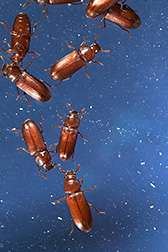Scientists Plot Genetic Ploy Against Grain Pest

(PhysOrg.com) -- Aided by a genomic map of the red flour beetle, Tribolium castaneum, Agricultural Research Service (ARS) and university scientists are plotting a kind of genetic sabotage on the pest’s basic life functions -- from locomotion to digestion.
Nationally, infestations of flour beetles and their beetle cousins cost millions of dollars in losses annually to stored grains and the food products made from those grains. Warehouse sanitation usually keeps beetle numbers down, but severe cases can necessitate the use of chemical controls. The problem is that T. castaneum has shown a propensity for developing resistance to insecticides.
As an alternative, a team of ARS and Kansas State University scientists is examining ways to exploit specific genes that regulate where, when and how a substance called chitin is used to form the beetle’s outer shell, or exoskeleton.
Led by ARS entomologist Richard Beeman, the team identified nine genes encoding specialized enzymes, dubbed “chitin deacetylases” (CDAs), which trim off branches of a long chain of simple sugars that make up raw chitin.
Which branches get trimmed depends on where chitin is needed on a developing beetle’s body, and for what purpose, explains Beeman, with the ARS Stored Product Insect Research Unit in Manhattan, Kan. For example, around leg joints, chitin’s branched-chain structure must be snipped to allow for flexibility and movement. But around the head and thorax, where protection of vital organs is key, a heavier, stiffer chitin deposition is needed, requiring a different form of CDA trimming.
Beeman and KSU collaborators Subbaratnam Muthukrishnan and Yasuyuki Arakane used a biotech procedure called “RNA interference” to demarcate the genes’ roles and observe what effect their elimination had on the insect’s development or survival. Some CDA-deficient strains developed in the lab couldn’t bend their legs as adult beetles, making it impossible for them to walk, mate or feed. Another such strain couldn’t shed its old exoskeleton.
Ultimately, such observations could open the door to chitin-disabling biopesticides or anti-chitin proteins engineered into crop plants.
Read more about this research in the November/December 2009 issue of Agricultural Research magazine.
Provided by USDA Agricultural Research Service
















